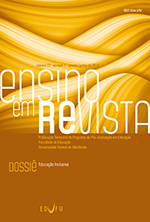Alunos com implante coclear: desenvolvimento e aprendizagem / Students with cochlear implants: development and learning
Main Article Content
Abstract
Inclusion of deaf students brings challenges, with unsatisfactory results, even with the participation of the interpreter and the resource room teacher. Deaf students with cochlear implants make situation more difficult because they interact among deaf peers who are sign language users and teachers do not have a neat information of how to deal with students with different features in the same class. This study aimed to investigate and analyze educational strategies used by teachers and the parents’ perception about linguistic development and learning. Classroom teachers, resource room teachers, one interpreter and parents were interviewed. Conclusion pointed that post lingual implanted students achieve better and among prelingual deaf implanted students, the ones who interact with sign language users and learn sign language at school have better academic achievement than the implanted deaf students whose parents opted by exclusive use of spoken language.
Article Details
Section

This work is licensed under a Creative Commons Attribution-NonCommercial-NoDerivatives 4.0 International License.
The published works are the property of their authors, who may make use of them for subsequent publications, always including the original edition (original title, Ensino em Re-Vista, volume, number, pages). All articles in this journal are the sole responsibility of their authors, and no legal responsibility for their content rests with the Journal or EDUFU.
How to Cite
References
BARDIN, L. Análise de conteúdo. Lisboa: Edições 70, 4ª. ed., 2011.
BEVILACQUA, M. C.; MORET, A. L. M. Reabilitação e implante coclear. In: LOPES FILHO, O. Tratado de fonoaudiologia. Ribeirão Preto: Tecmed, 2005, cap. 23, p. 423-436.
COLE, M.; COLE, S. O desenvolvimento da criança e do adolescente. Porto Alegre: Artmed, 2004.
COLLETTI, V. Cochlear Implantation at under 12 months: Report on 10 Patients. The Laryngoscope, v. 115, n.3, p. 445-449, 2005.
GESUELI, Z. M. A escrita como fenômeno visual nas práticas discursivas de alunos surdos. In: LODI, A.C.B.; MELO, A.D.B.; FERNANDES, E. (Orgs.) Letramento, bilinguismo e educação de surdos. Porto Alegre: Mediação, 2012
.GUIMARÃES, A. D. S.; KELMAN, C.A. & NASCIMENTO, R.T. Expectativas dos pais quanto aos benefícios do implante coclear em contextos educacionais bilíngues. Trabalho apresentado no VII Congresso Multidisciplinar de Educação Especial, nov. 2013. Londrina.
KELMAN, C. A. Aqui tudo é importante! Interações de alunos surdos com professores e colegas em espaço escolar inclusivo. 2005. 197 f. Tese (Doutorado em Psicologia). Brasília: UnB.
_____________. Dilemas sobre o implante coclear: implicações linguísticas e pedagógicas. Informativo Técnico-Científico Espaço INES. Rio de Janeiro, v. 33, p. 33-41, jan-jun 2010.
_____________. Significação e aprendizagem do aluno surdo. In: MARTINEZ, A.; TACCA, C.V.R.: Possibilidades de aprendizagem: ações pedagógicas para alunos com dificuldades e deficiências. Campinas, SP: 2011, p. 175-208.
_______.; BRANCO, A. U. Deaf children in regular classrooms: a sociocultural approach to a Brazilian experience. American Annals of the Deaf, Washington: Gallaudet University, v. 149, n. 3, p. 274-280, 2004.
_______.; BRANCO, A. U. Comunicação e Metacomunicação na Inclusão Escolar. In: DESSEN, M. A. e MACIEL, D. A. (Orgs.) A Ciência do Desenvolvimento Humano: desafios para a Psicologia e a Educação.Curitiba, PR: Ed. Juruá, 2014, p. 483-516.
KELMAN, C.A.; LIMA, P. O. Inclusão de aluno com implante coclear no contexto do bloco inicial de alfabetização. Comunicação oral apresentada no V Congresso Multidisciplinar de Educação Especial, nov. 2009. Londrina.
KELMAN, C.A.; BARBOSA, I.S. Aluno com implante coclear: reflexos pedagógicos de uma identidade em formação.Comunicação oral apresentada no V Congresso Multidisciplinar de Educação Especial, nov. 2009. Londrina.
LAURENT CLERC NATIONAL DEAF EDUCATION CENTER. Cochlear implants and sign language: putting it all together (Identifying practices for educational settings). Washington, D.C., 2003.
LOPES, V.P.; MAIA, J.A.R. Períodos críticos ou sensíveis: revisitar um tema polêmico à luz da investigação empírica. Revista Brasileira de Educação Física, São Paulo, v. 14, n.2,p. 128-140, jul/dez,2000.
MITTLER, P. Educação inclusiva. Porto Alegre: Artmed, 2003.
MIYAMOTO, R.T.; HOUSTON, D.M.; BERGESON, T. Cochlear implantation in deaf infants. The Laryngoscope, v.115, n.8, p.1376-1380, ago/2005.
PEREIRA, M.C. da. Papel da língua de sinais na aquisição da escrita por estudantes surdos. 2012. . In: LODI, A.C.B.; MELO, A.D.B.; FERNANDES, E. (Orgs.) Letramento, bilinguismo e educação de surdos. Porto Alegre: Mediação, 2012
.PONTECORVO, C; AJELLO, A.M.; ZUCCHERMAGLIO, C. Discutindo se aprende. Porto Alegre: Artmed, 2005.
QUEIROZ, E.F.; KELMAN, C. A. Implicações do implante coclear no processo de aquisição da escrita de uma criança surda. In: TANAKA, E.D.O.; MARQUEZINE, M. C.; BUSTO, R.M., 2009, p. 103-115.
SHARMA, A.; CAMPBELL, J, 2011. A sensitive period for cochlear implantation in deaf children. Journal of Maternal Fetal Neonatal Medicine, 2011 Oct. 24 Suppl 1:151-153. doi: 10.3109/14767058.2011.607614.
TAVEIRA, C.C. et alii. Proposta de Educação Bilíngue voltada à surdez no município do Rio de Janeiro.Texto didático disponível em: http://ihainforma.wordpress.com. Acesso em 25/11/2013.
YAMADA, M.O.; BEVILAQUA, M.C. O papel do psicólogo no programa de implante coclear do Hospital de Reabilitação de Anomalias Craniofaciais. Estudos de Psicologia, Campinas, v. 22, p. 255-262, 2005.

